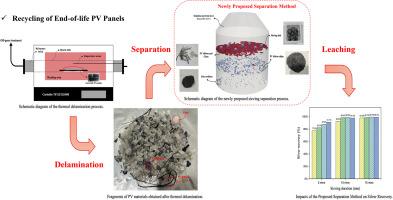改善颗粒分离和回收废旧太阳能电池板中有价值的材料
IF 10.9
1区 环境科学与生态学
Q1 ENGINEERING, ENVIRONMENTAL
引用次数: 0
摘要
大量的光伏组件将退役,必须进行适当的回收,但目前的方法无法回收报废的光伏电池板,特别是以可行的方式回收银和硅等有价值的材料。本研究开发了一种高效的回收方法,采用新型助筛技术实现太阳能电池与玻璃的高效分离,上游热解分层,下游化学浸出回收银。结果表明,在优化的筛分条件下,新型助筛技术可从碎屑混合物中分离出超过96.3 wt.%的片状光伏电池颗粒,而传统筛分方法的分离率为31.7%。分离过程中收集的PV电池颗粒,在烧杯中用4M硝酸在40℃下浸出30 min,用于提银。浸出结果表明,该方法可回收光伏组件中98.9%以上的银。该研究为高效回收报废光伏组件提供了一种新方法。本文章由计算机程序翻译,如有差异,请以英文原文为准。

Improving particle separation and recovery of valuable materials from end-of-life solar panels
Massive photovoltaic (PV) modules will be decommissioned and must be properly recycled, but the current methods cannot recycle end-of-life PV panels especially recovering valuable materials like silver and silicon in a feasible way. In this study, a highly efficient recycling method is developed, featuring a novel sieving aids technology for high-efficiency separation of solar cells and glass, connected with the upstream pyrolysis for delamination and downstream chemical leaching for silver recovery. The results indicate that over 96.3 wt.% of the chip-like PV cell particles can be separated from the debris mixture under the optimised sieving conditions using the new sieving aids technology, compared to the separation rate of 31.7% in the conventional sieving methods. The PV cell particles collected by the separation process are further leached by the 4M nitric acid at 40°C for 30 mins in a beaker for silver extraction. The leaching result shows that over 98.9% of the silver contained in the PV modules can be recovered by this integrated method. The study provides a new method for a highly efficient recycling process of end-of-life PV modules.
求助全文
通过发布文献求助,成功后即可免费获取论文全文。
去求助
来源期刊

Resources Conservation and Recycling
环境科学-工程:环境
CiteScore
22.90
自引率
6.10%
发文量
625
审稿时长
23 days
期刊介绍:
The journal Resources, Conservation & Recycling welcomes contributions from research, which consider sustainable management and conservation of resources. The journal prioritizes understanding the transformation processes crucial for transitioning toward more sustainable production and consumption systems. It highlights technological, economic, institutional, and policy aspects related to specific resource management practices such as conservation, recycling, and resource substitution, as well as broader strategies like improving resource productivity and restructuring production and consumption patterns.
Contributions may address regional, national, or international scales and can range from individual resources or technologies to entire sectors or systems. Authors are encouraged to explore scientific and methodological issues alongside practical, environmental, and economic implications. However, manuscripts focusing solely on laboratory experiments without discussing their broader implications will not be considered for publication in the journal.
 求助内容:
求助内容: 应助结果提醒方式:
应助结果提醒方式:


